Conventional and Alternative Sources of Thermal Energy in the Production of Cement—An Impact on CO2 Emission
Abstract
1. Introduction
2. Cement Manufacturing Process
3. Materials and Methods
- is CO2 emission from the combustion process by type of fuel in Mg CO2 per hour;
- is the amount of fuel combusted mass converted into the energy content of this fuel in TJ per hour;
- is the CO2 emission factor in Mg CO2/TJ.
- is the CO2 emission factor in Mg CO2/TJ;
- is a molecular weight ratio of CO2 to C;
- is carbon content of combusted fuel in %;
- is calorific value in TJ/Mg.
- is the average CO2 total heat demand to produce clinker in MJ per year;
- is average capacity of cement kiln in Mg per year;
- is specific heat consumption per ton of clinker in MJ/Mg.
4. Results and Discussion
4.1. Alternative Fuels Characteristic
4.2. Mass Balance in Co-Combustion of Coal and Alternative Fuel
4.3. CO2 Emission Balance
5. Conclusions
Author Contributions
Funding
Institutional Review Board Statement
Informed Consent Statement
Conflicts of Interest
References
- Pardo, N.; Moya, J.A.; Mercier, A. Prospective on the energy efficiency and CO2 emissions in the EU cement industry. Energy 2011, 36, 3244–3254. [Google Scholar] [CrossRef]
- Talaei, A.; Pier, D.; Iyer, A.V.; Ahiduzzaman, M.; Kumar, A. Assessment of long-term energy efficiency improvement and greenhouse gas emissions mitigation options for the cement industry. Energy 2019, 170, 1051–1066. [Google Scholar] [CrossRef]
- Cloete, S.; Giuffrida, A.; Romano, M.C.; Zaabout, A. Economic assessment of the swing adsorption reactor cluster for CO2 capture from cement production. J. Clean. Prod. 2020, 275, 123024. [Google Scholar] [CrossRef]
- Polish Cement Association. 2020. Available online: https://www.polskicement.pl/wyniki/ (accessed on 14 January 2021).
- Statistical Review of World Energy, 69th ed; 2020; Available online: https://www.bp.com/content/dam/bp/business-sites/en/global/corporate/pdfs/energy-economics/statistical-review/bp-stats-review-2020-full-report.pdf (accessed on 14 January 2021).
- Mokhtar, A.; Nasooti, M. A decision support tool for cement industry to select energy efficiency measures. Energy Strateg. Rev. 2020, 28, 100458. [Google Scholar] [CrossRef]
- Habert, G. Assessing the environmental impact of conventional and ‘green’ cement production. In Eco-Efficient Construction and Building Materials; Elsevier: Amsterdam, The Netherlands, 2014. [Google Scholar] [CrossRef]
- CEMBUREAU The European Cement Association. Cementing the European Green Deal, Reaching Climate Neutrality along the Cement and Concrete Value Chain by 2050. Available online: https://cembureau.eu/media/kuxd32gi/cembureau-2050-roadmap_final-version_web.pdf (accessed on 29 July 2020).
- Saidur, R.; Hossain, M.S.; Islam, M.R.; Fayaz, H.; Mohammed, H.A. A review on kiln system modeling. Renew. Sustain. Energy Rev. 2011, 15, 2487–2500. [Google Scholar] [CrossRef]
- Gao, T.; Shen, L.; Shen, M.; Liu, L.; Chen, F. Analysis of material flow and consumption in cement production process. J. Clean. Prod. 2016, 112, 553–565. [Google Scholar] [CrossRef]
- Kuteryńska, J.; Król, A. New types of low-carbon cements with reduced Portland clinker content as a result of ecological actions of cement industry towards sustainable development. J. Environ. Stud. 2016, 16, 403–419. [Google Scholar]
- Navarrete, I.; Vargas, F.; Martinez, P.; Paul, A.; Lopez, M. Flue gas desulfurization (FGD) fly ash as a sustainable, safe alternative for cement-based materials. J. Clean. Prod. 2021, 283, 124646. [Google Scholar] [CrossRef]
- Supino, S.; Malandrino, O.; Testa, M.; Sica, D. Sustainability in the EU cement industry: The Italian and German experiences. J. Clean. Prod. 2016, 112, 430–442. [Google Scholar] [CrossRef]
- Chatziaras, N.; Psomopoulos, C.S.; Themelis, N.J. Use of waste derived fuels in cement industry: A review. Manag. Environ. Qual. Int. J. 2016, 27, 178–193. [Google Scholar] [CrossRef]
- Kobize. Calorific Values (CO) and CO2 Emission Factors (EC) in 2016 for Reporting under the Emission Trading Scheme for 2019. Available online: https://www.kobize.pl/uploads/materialy/WO_i_WE_do_monitorowania-ETS-2019.pdf (accessed on 29 July 2020).
- Wzorek, M.; Król, A. Assessment of the quality of fuels from waste used in coal co-firing processes. Sci. Work. Inst. Ceram. Build. Mater. 2012, 5, 444–465. [Google Scholar]
- Regulation of the Minister of Climate of 2 January 2020 on the Catalogue of Wastes. (Journal of Laws of 2020 item 10). 2020. Available online: https://www.gov.pl/attachment/f4905905-e985-4344-a79e-71e51163afac (accessed on 10 March 2021).
- European Standard. Solid Recovered Fuels—Terminology, Definitions and Descriptions; EN 15357:2011; CEN: Brussels, Belgium, 2011. [Google Scholar]
- Manninen, H. Co-combustion of refuse derived and packaging-derived fuels (RDF and PDF) with conventional fuels. Waste Manag. Res. 1997, 15, 137–147. [Google Scholar] [CrossRef]
- Martignon, G.P. Trends in the Use of Solid Recovered Fuels; IEA Bioenergy: Paris, France, 2020; Available online: https://www.ieabioenergy.com/wp-content/uploads/2020/05/Trends-in-use-of-solid-recovered-fuels-Main-Report-Task36.pdf (accessed on 3 March 2021).
- Kang, S.; Kim, S.; Lee, J.; Jeon, Y.; Kim, K.H.; Jeon, E. Study on applying biomass fraction for greenhouse gases emission estimation of a sewage sludge incinerator in Korea: A case study. Sustainability 2017, 9, 557. [Google Scholar] [CrossRef]
- Wojtacha-Rychter, K.; Smolinski, A. The CO2, CO and H2 emission profile from thermal oxidation of Polish coals. Materials 2020, 13, 848. [Google Scholar] [CrossRef] [PubMed]
- Koteras, A.; Checko, J.; Urych, T.; Magdziarczyk, M.; Smolinski, A. An Assessment of the Formations and Structures Suitable for Safe CO2 Geological Storage in the Upper Silesia Coal Basin in Poland in the Context of the Regulation Relating to the CCS. Energies 2020, 13, 195. [Google Scholar] [CrossRef]
- Chećko, J.; Urych, T.; Magdziarczyk, M.; Smoliński, A. Research on the processes of injecting CO2 into coal seams with CH4 recovery using horizontal wells. Energies 2020, 13, 416. [Google Scholar] [CrossRef]
- Zhou, W.; Jiang, D.; Chen, D.; Griffy-Brown, C.; Jin, Y.; Zhu, B. Capturing CO2 from cement plants: A priority for reducing CO2 emissions in China. Energy 2016, 106, 464–474. [Google Scholar] [CrossRef]
- Chatterjee, A.; Sui, T. Alternative fuels–effects on clinker process and properties. Cem. Concr. Res. 2019, 123, 105777. [Google Scholar] [CrossRef]
- Serrano-González, K.; Reyes-Valdez, A.; Chowaniec, O. Impact of the use of alternative fuels on clinker reactivity. Mater. Construcc. 2017, 67, 120. [Google Scholar] [CrossRef]
- Strigáč, J. Effect of Selected Alternative Fuels and Raw Materials on the Cement Clinker Quality. Sel. Sci. Pap. J. Civ. Eng. 2015, 10, 81–92. [Google Scholar] [CrossRef]
- European Cement Association. 2019 Activity Report. 2019. Available online: http://www.cembureau.eu/media/clkdda45/activity-report-2019.pdf (accessed on 1 March 2021).
- Gonçalves, M.C.; Margarido, F. Materials for Construction and Civil Engineering, 2015th ed.; Springer International Publishing: Cham, Switzerland, 2015. [Google Scholar] [CrossRef]
- Kurdowski, W. Cement and Concrete Chemistry; Springer: Dordrecht, The Netherlands, 2014. [Google Scholar] [CrossRef]
- Stafford, F.N.; Dias, A.C.; Arroja, L.; Labrincha, J.A.; Hotza, D. Life cycle assessment of the production of Portland cement: A Southern Europe case study. J. Clean. Prod. 2016, 126, 159–165. [Google Scholar] [CrossRef]
- Łączny, M.J.; Iwaszenko, S.; Smolinski, A. Process kinetics of the carbonation of fly ashes and their utilization as cement and concrete admixtures: A research study. Materials 2021, 14, 253. [Google Scholar] [CrossRef] [PubMed]
- Rahman, A.; Rasul, M.G.; Khan, M.M.K.; Sharma, S. Impact of alternative fuels on the cement manufacturing plant performance: An overview. Procedia Eng. 2013, 56, 393–400. [Google Scholar] [CrossRef]
- 2006 IPCC Guidelines for National Greenhouse Gas Inventories, Volume 2, Energy, Stationary Combustion. 2006. Available online: https://www.ipcc-nggip.iges.or.jp/public/2006gl/pdf/2_Volume2/V2_2_Ch2_Stationary_Combustion.pdf (accessed on 1 March 2021).
- Pamungkas, B.C.; Hadi, H. Potential of biomass utilization in rotary kiln of nickel processing plant. IOP Conf. Ser. Mater. Sci. Eng. 2019, 588, 12006. [Google Scholar] [CrossRef]
- Johnke, B. Background Papers. IPCC Expert Meetings on Good Practice Guidance and Uncertainty Management in National Greenhouse Gas Inventories; Emission from Waste Incineration; Intergovernmental Panel on Climate Change (IPCC): Geneva, Switzerland, 2020; pp. 455–468. Available online: https://www.ipcc-nggip.iges.or.jp/public/gp/bgp/5_3_Waste_Incineration.pdf (accessed on 14 December 2020).
- Mikulcic, H.; Vujanovic, M.; Markovska, N.; Filkoski, R.; Ban, M.; Duic, N. CO2 emission reduction in the cement industry. Chem. Eng. Trans. 2013, 35, 703–708. [Google Scholar] [CrossRef]
- European Energy Exchange. EUA Primary Market Auction Report 2020. Emission Spot Primary Market Auction Report 2020. 2020. Available online: https://www.eex.com/en/market-data/environmental-markets/eua-primary-auction-spot-download (accessed on 30 December 2020).
- Schwarzböck, T.; Aschenbrenner, P.; Spacek, S.; Szidat, S.; Rechberger, H.; Fellner, J. An alternative method to determine the share of fossil carbon in solid refuse-derived fuels—Validation and comparison with three standardized methods. Fuel 2018, 220, 916–930. [Google Scholar] [CrossRef]
- Gerassimidou, S.; Velis, C.A.; Williams, P.T.; Komilis, D. Characterisation and composition identification of waste-derived fuels obtained from municipal solid waste using thermogravimetry: A review. Waste Manag. Res. 2020, 38, 942–965. [Google Scholar] [CrossRef]
- Samolada, M.C.; Zabaniotou, A.A. Energetic valorization of SRF in dedicated plants and cement kilns and guidelines for application in Greece and Cyprus. Resour. Conserv. Recycl. 2014, 83, 34–43. [Google Scholar] [CrossRef]
- Rezaei, H.; Yazdan Panah, F.; Lim, C.J.; Sokhansanj, S. Pelletization of Refuse-Derived Fuel with Varying Compositions of Plastic, Paper, Organic and Wood. Sustainability 2020, 12, 4645. [Google Scholar] [CrossRef]
- Żygadło, M.; Purgał, P. The benefits of partial substitution of fossil fuel with alternative fuel in cement plant. Case study. Environ. Prot. Eng. 2020, 46. [Google Scholar] [CrossRef]
- Iacovidou, E.; Hahladakis, J.; Deans, I.; Velis, C.; Purnell, P. Technical properties of biomass and solid recovered fuel (SRF) co-fired with coal: Impact on multi-dimensional resource recovery value. Waste Manag. 2018, 73, 535–545. [Google Scholar] [CrossRef]
- U.S. Energy Information Administration (EIA). Coal Prices and Outlook. 2019. Available online: https://www.eia.gov/energyexplained/coal/prices-and-outlook.php (accessed on 7 July 2020).
- Środa, B. Climate Neutrality and the Prospects for the Use of Concrete and Cement in Construction. Polish Cement Association. Available online: https://kongresdrogowy.pl/files/upload/OST2020_BSroda.pdf (accessed on 1 March 2021).
- Kucharski, P.; Białecka, B. Poultry manure as a substrate for agriculture and the chemical industry. Int. Multidiscip. Sci. Geo Conf. SGEM 2019, 19, 611–618. [Google Scholar] [CrossRef]
- Pröll, T.; Zerobin, F. Biomass-based negative emission technology options with combined heat and power generation. Mitig. Adapt. Strateg. Glob. Chang. 2019, 24, 1307–1324. [Google Scholar] [CrossRef]
- IPCC. Agriculture, Forestry and Other Land Use. Intergovernmental Panel on Climate Change, IPCC Guidelines for National Greenhouse Gas Inventories. 2006. Available online: http://www.ipcc-nggip.iges.or.jp/public/2006gl/vol4.html (accessed on 3 March 2021).
- Thakur, A.; Canter, C.E.; Kumar, A. Life-cycle energy and emission analysis of power generation from forest biomass. Appl. Energy 2014, 128, 246–253. [Google Scholar] [CrossRef]
- Petersen Raymer, A.K. A comparison of avoided greenhouse gas emissions when using different kinds of wood energy. Biomass Bioenergy 2006, 30, 605–617. [Google Scholar] [CrossRef]
- Sedjo, R.A. Comparative Life Cycle Assessments: Carbon Neutrality and Wood Biomass Energy; Discussion Papers; Resources for the Future: Washington, DC, USA, 2013; pp. 11–13. [Google Scholar] [CrossRef][Green Version]
- Börjesson, P.; Gustavsson, L. Greenhouse gas balances in building construction: Wood versus concrete from life-cycle and forest land-use perspectives. Energy Policy 2000, 28, 575–588. [Google Scholar] [CrossRef]
- Johnson, E. Goodbye to carbon neutral: Getting biomass footprints right. Environ. Impact Assess. Rev. 2009, 29, 165–168. [Google Scholar] [CrossRef]
- Sanjuán, M.Á.; Andrade, C.; Mora, P.; Zaragoza, A. Carbon dioxide uptake by cement-based materials: A Spanish case study. Appl. Sci. 2020, 10, 339. [Google Scholar] [CrossRef]
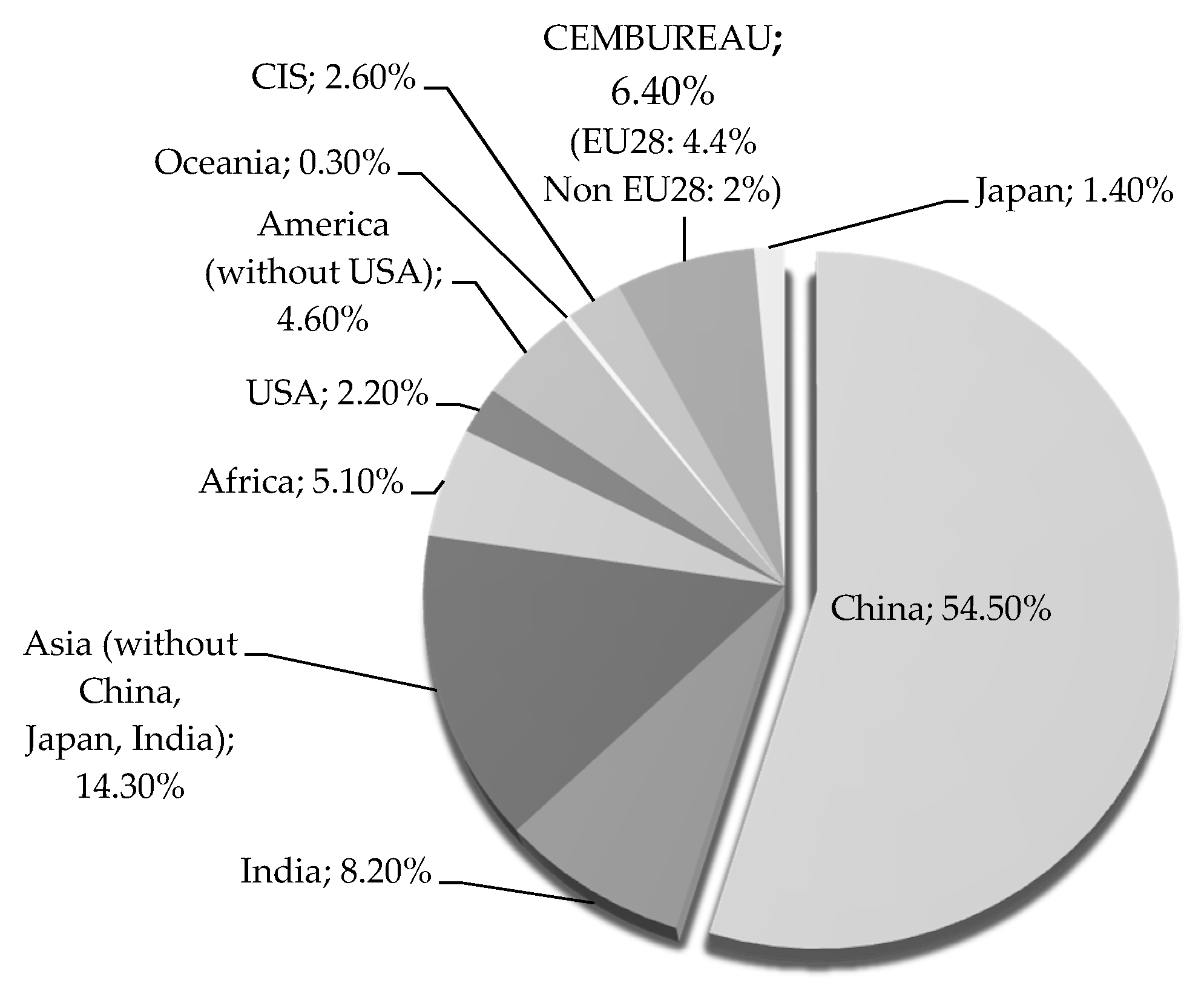
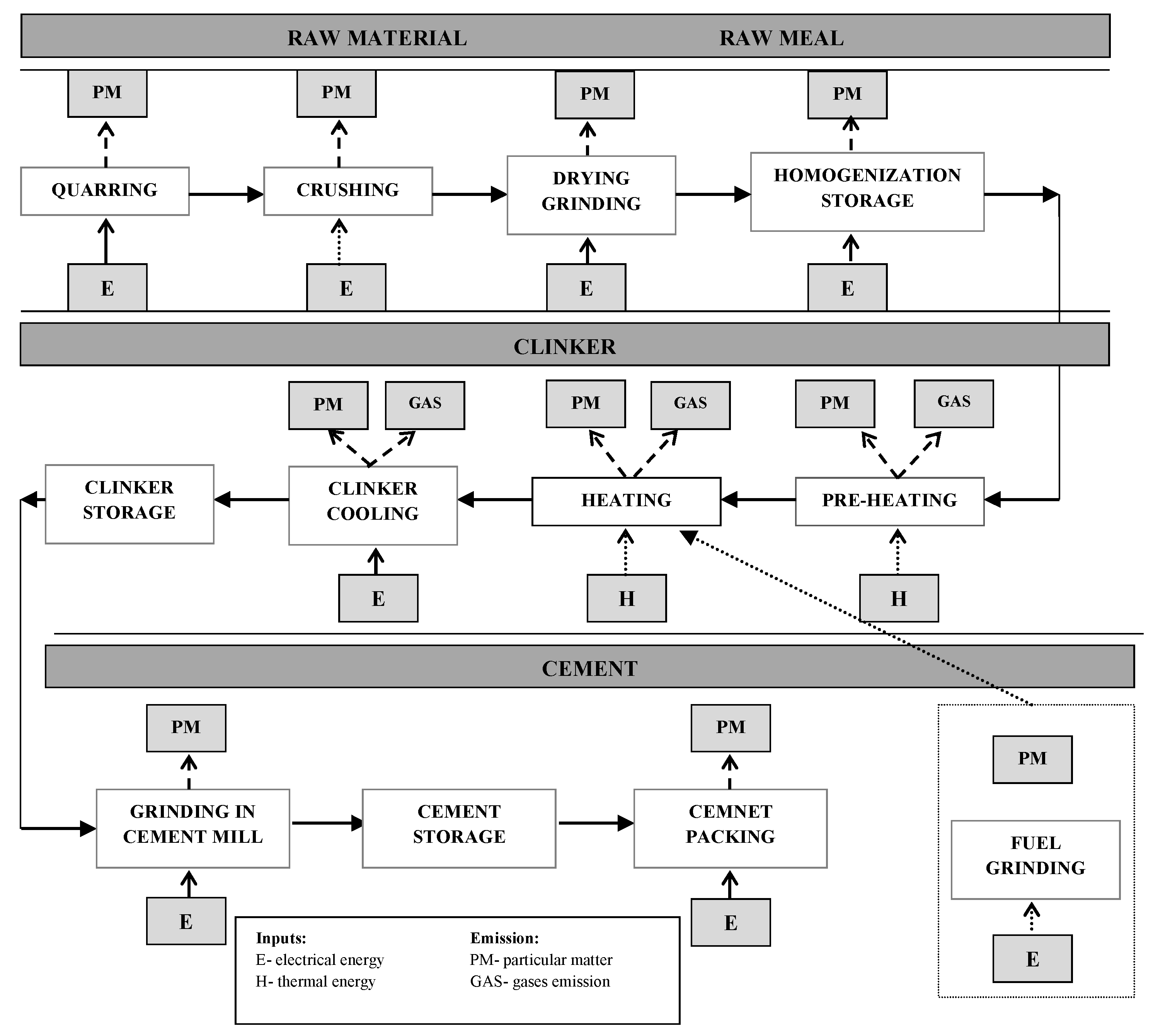

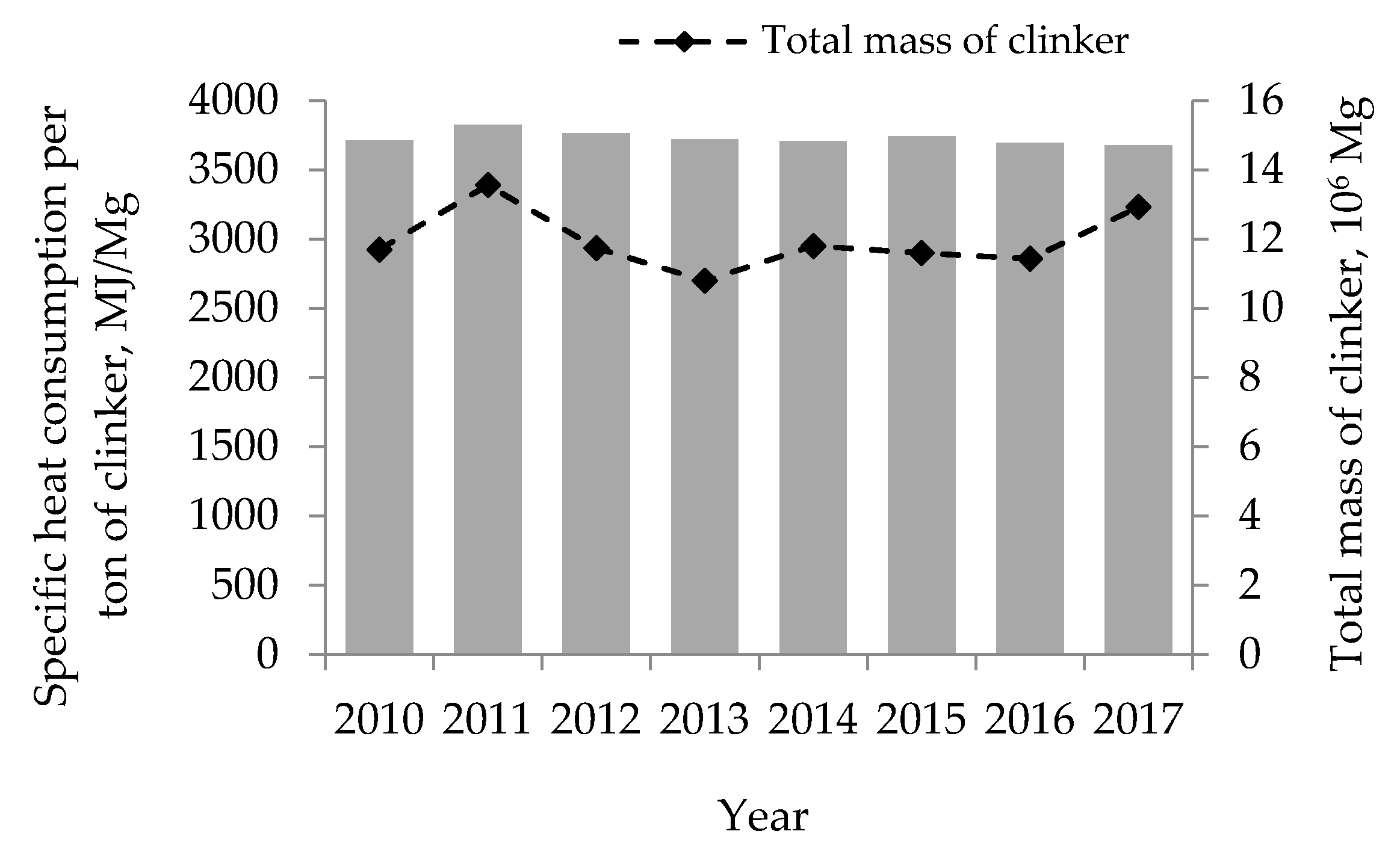
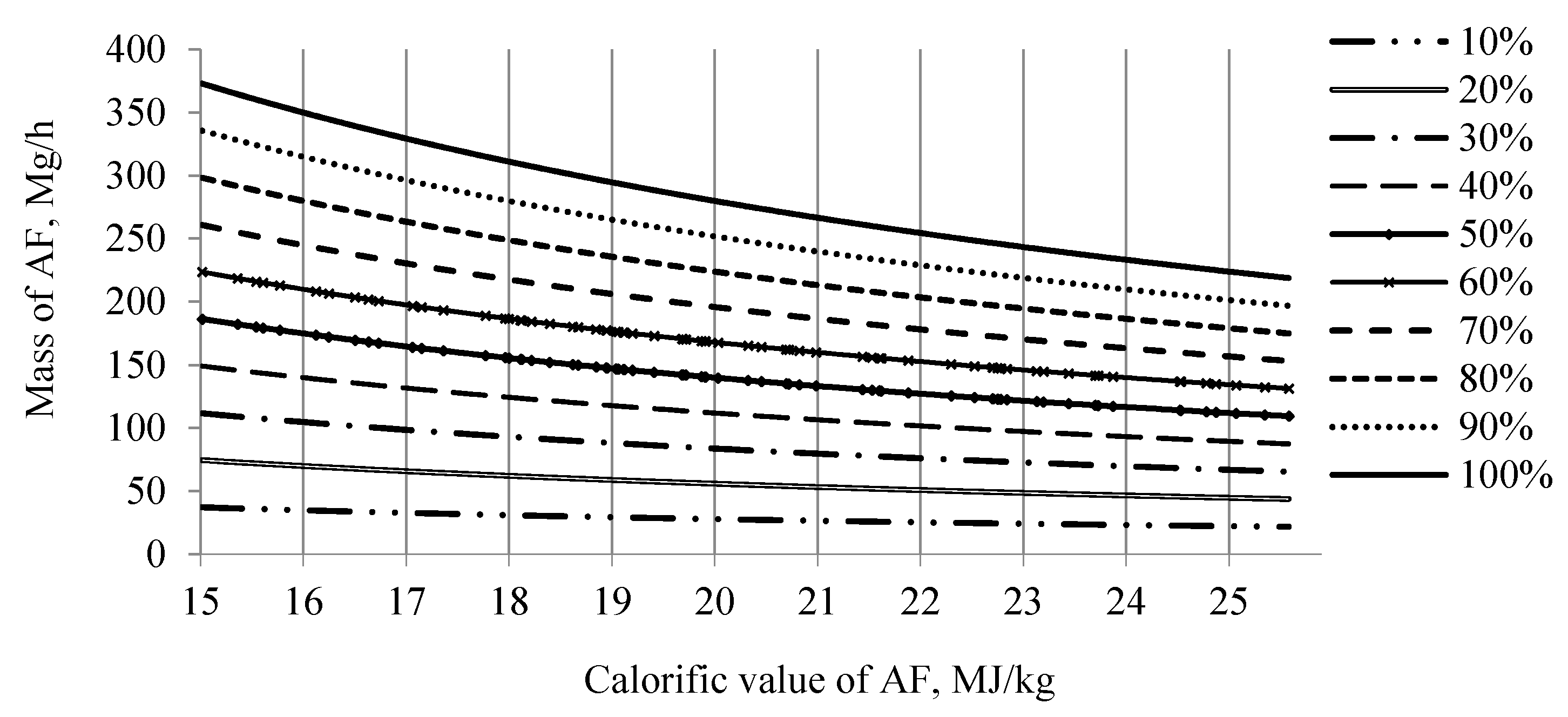
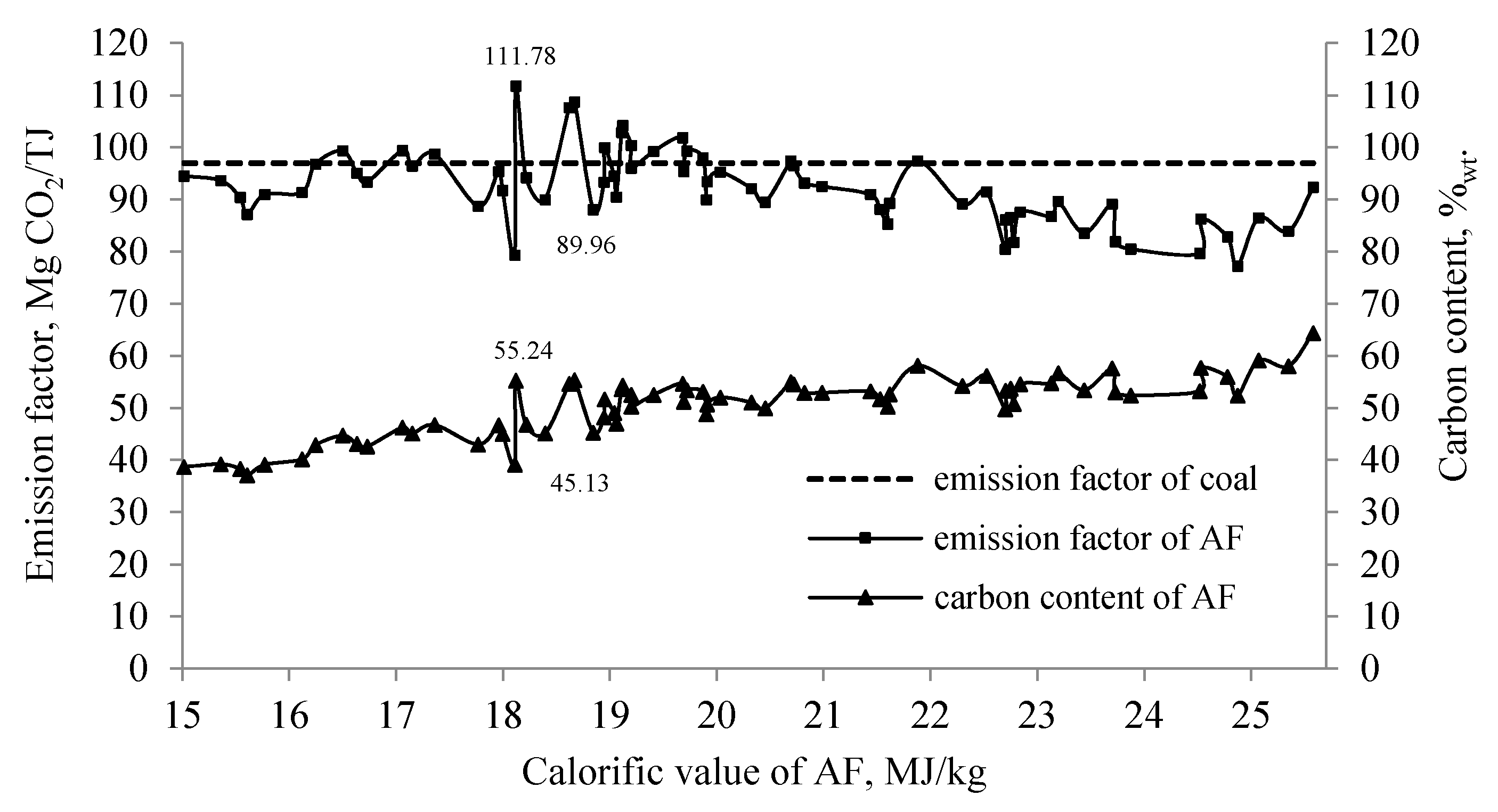
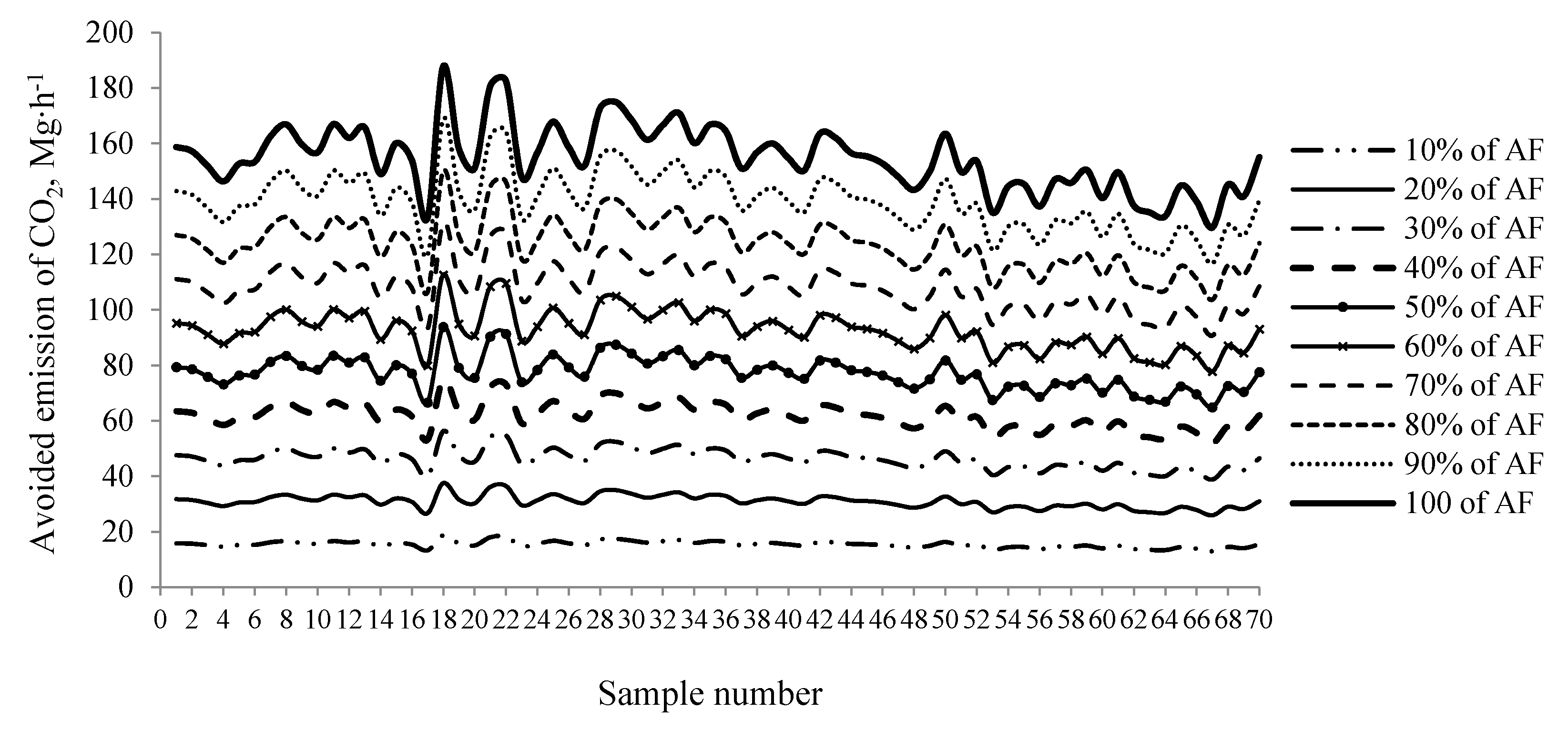
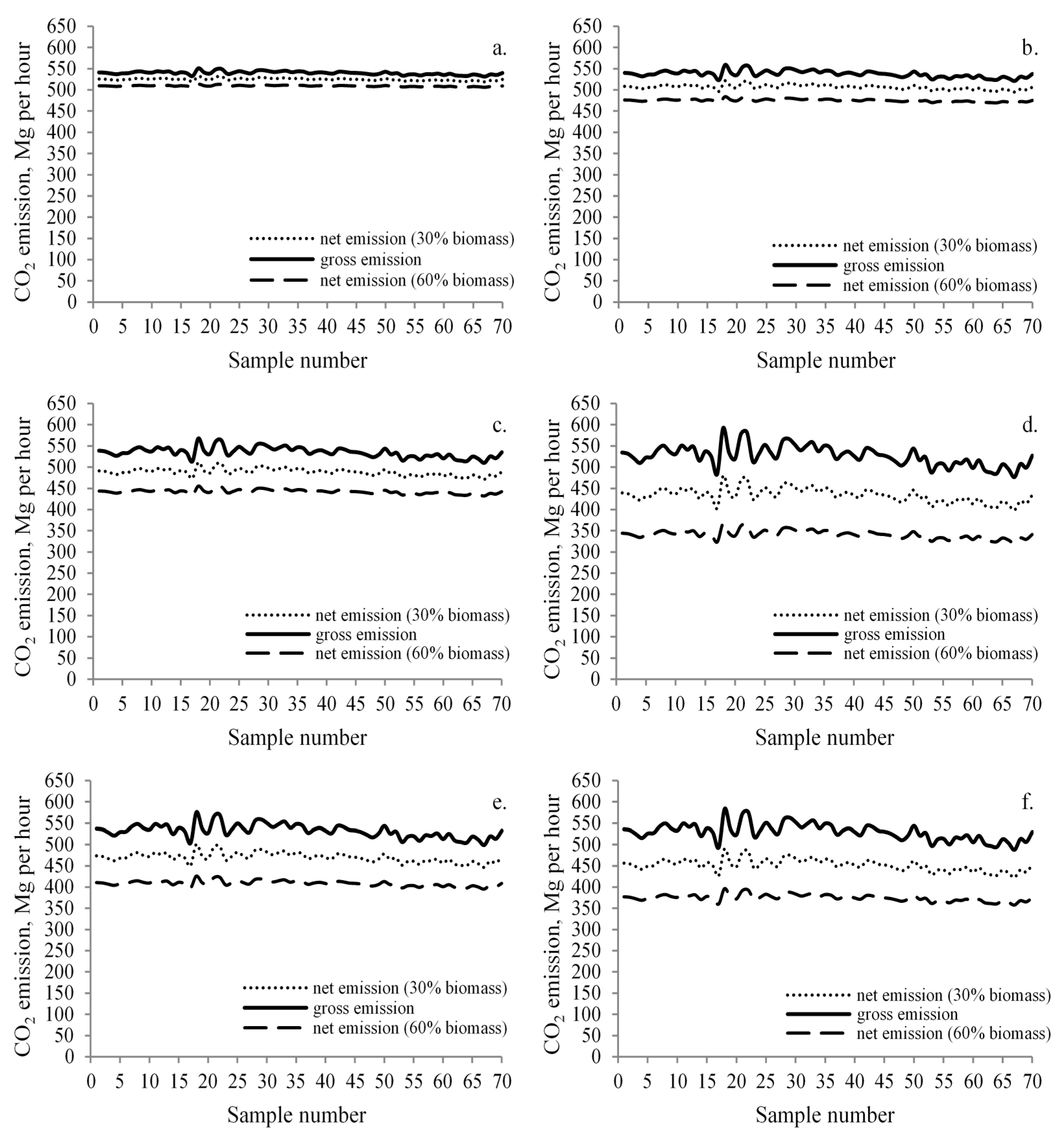
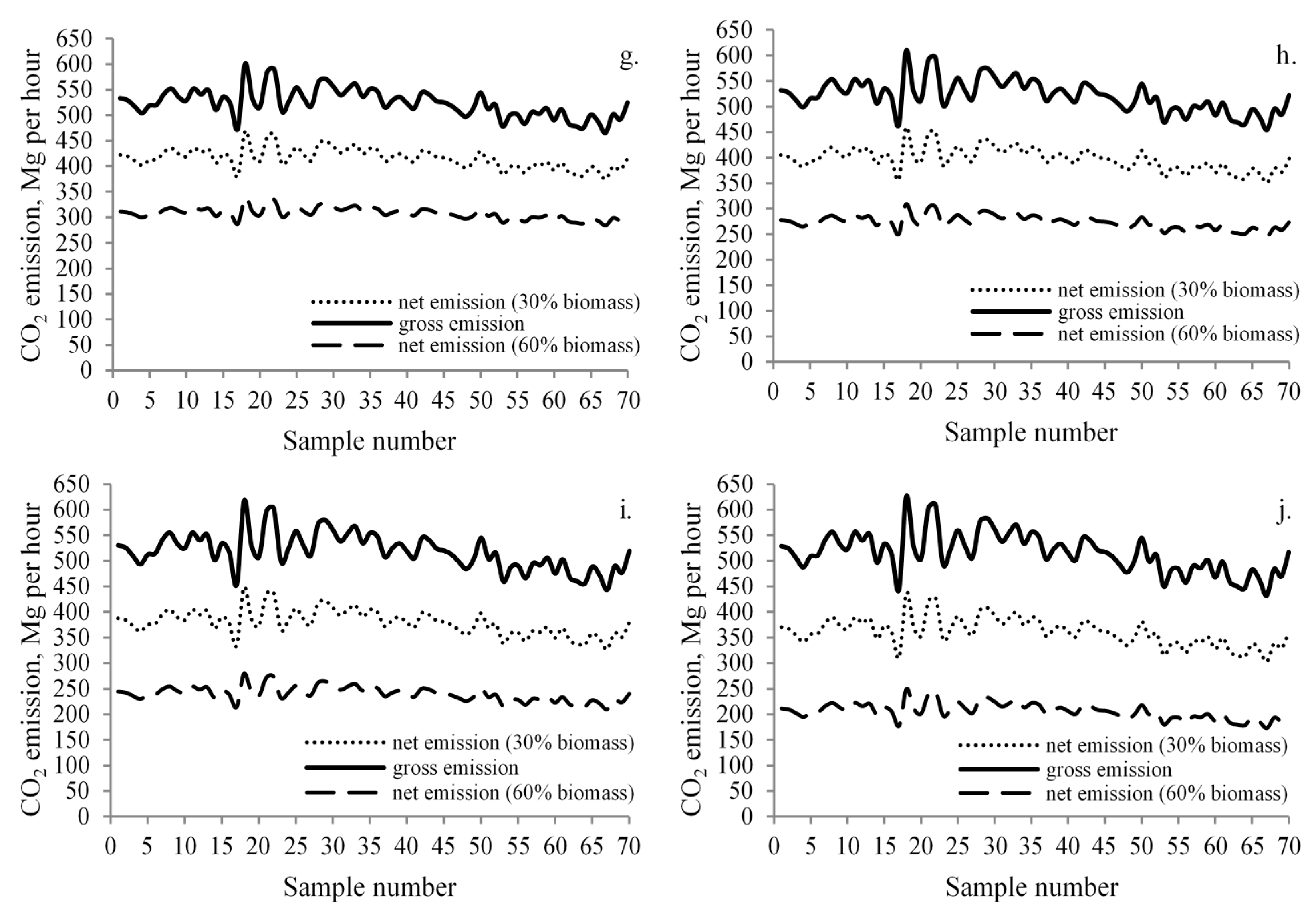
| Fuel Type | Options | ||||||||||
|---|---|---|---|---|---|---|---|---|---|---|---|
| 1 | 2 | 3 | 4 | 5 | 6 | 7 | 8 | 9 | 10 | 11 | |
| Coal | 100% | 90% | 80% | 70% | 60% | 50% | 40% | 30% | 20% | 10% | 0% |
| Alternative fuel | 0% | 10% | 20% | 30% | 40% | 50% | 60% | 70% | 80% | 90% | 100% |
| Share of Heat from AF Fuels | Mass Saving of the Coal | Cost Savings |
|---|---|---|
| Mg∙h−1 | €∙h−1 | |
| 10% | 19.43 | 923 |
| 20% | 38.86 | 1847 |
| 30% | 58.29 | 2770 |
| 40% | 77.72 | 3693 |
| 50% | 97.15 | 4617 |
| 60% | 116.58 | 5540 |
| 70% | 136.02 | 6463 |
| 80% | 155.45 | 7387 |
| 90% | 174.88 | 8310 |
| Share of Heat from AF Fuels | Avoiding CO2 Emission (30% of Biomass) | Benefits of Fees from Avoided Emission of CO2 | |
|---|---|---|---|
| Mg CO2∙h−1 | €∙h−1 | €∙year−1 | |
| 10% | 15.48 | 465 | 3,720,268 |
| 20% | 30.96 | 930 | 7,440,536 |
| 30% | 46.44 | 1395 | 11,160,804 |
| 40% | 61.92 | 1860 | 14,881,072 |
| 50% | 77.40 | 2325 | 18,601,341 |
| 60% | 92.88 | 2790 | 22,321,609 |
| 70% | 108.36 | 3255 | 26,041,877 |
| 80% | 123.84 | 3720 | 29,762,145 |
| 90% | 139.32 | 4185 | 33,482,413 |
| 100% | 154.80 | 4650 | 37,202,681 |
Publisher’s Note: MDPI stays neutral with regard to jurisdictional claims in published maps and institutional affiliations. |
© 2021 by the authors. Licensee MDPI, Basel, Switzerland. This article is an open access article distributed under the terms and conditions of the Creative Commons Attribution (CC BY) license (http://creativecommons.org/licenses/by/4.0/).
Share and Cite
Wojtacha-Rychter, K.; Kucharski, P.; Smolinski, A. Conventional and Alternative Sources of Thermal Energy in the Production of Cement—An Impact on CO2 Emission. Energies 2021, 14, 1539. https://doi.org/10.3390/en14061539
Wojtacha-Rychter K, Kucharski P, Smolinski A. Conventional and Alternative Sources of Thermal Energy in the Production of Cement—An Impact on CO2 Emission. Energies. 2021; 14(6):1539. https://doi.org/10.3390/en14061539
Chicago/Turabian StyleWojtacha-Rychter, Karolina, Piotr Kucharski, and Adam Smolinski. 2021. "Conventional and Alternative Sources of Thermal Energy in the Production of Cement—An Impact on CO2 Emission" Energies 14, no. 6: 1539. https://doi.org/10.3390/en14061539
APA StyleWojtacha-Rychter, K., Kucharski, P., & Smolinski, A. (2021). Conventional and Alternative Sources of Thermal Energy in the Production of Cement—An Impact on CO2 Emission. Energies, 14(6), 1539. https://doi.org/10.3390/en14061539







